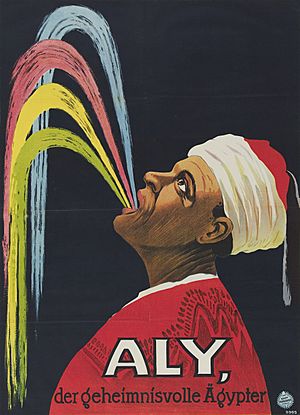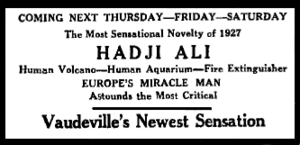Hadji Ali facts for kids
Quick facts for kids
Hadji Ali
|
|
|---|---|

1913 Adolph Friedländer company poster; the German-language caption translates as "Ali, the mysterious Egyptian"
|
|
| Born |
Hadji Ali
c. 1887–92 |
| Died | November 5, 1937 (aged 45 - 49) Wolverhampton, England
|
| Resting place | Kensico Cemetery, Valhalla, New York |
| Other names | The Great Egyptian Miracle Man The Amazing Regurgitator The Egyptian Enigma The Human Volcano The Human Aquarium The 9th Wonder of the Scientific World |
| Occupation | Vaudeville performance artist |
Hadji Ali (Arabic: حاج علي) (around 1887–92 – November 5, 1937) was a special kind of performer. He was famous for his amazing acts of controlled regurgitation. This means he could swallow things and then bring them back up whenever he wanted.
Ali's most famous tricks included spouting water like a fountain. He could also swallow smoke and then blow it out. Another popular stunt was swallowing nuts and handkerchiefs. He would then bring them back up in any order the audience asked for. His most exciting act involved drinking lots of water, then kerosene. He would then act like a human flamethrower and then a fire extinguisher. He would spit the liquids onto a prop, setting it on fire, then putting it out. People from the audience were often invited to watch closely. This was to make sure he wasn't using any tricks.
Even though he wasn't super famous, many people loved his shows. He performed for important leaders like Tsar Nicholas II of Russia. Famous singer Judy Garland said he was her favorite performer. Magician David Blaine also called Ali his favorite magician. Parts of his act were shown in short films. People even thought a famous university wanted to study his stomach after he died!
Contents
Early Life and Discovery of Talent
Hadji Ali was born in Egypt, likely between 1887 and 1892. He grew up in a working-class family. From a young age, he realized he had a very unusual skill. He could swallow things and bring them back up. This type of act was known as a "regurgitation act" in vaudeville shows.
Ali once explained how he found his talent. When he was about ten years old, he was swimming in the Nile River. He found he could swallow a lot of water. Then he could blow it out just like a whale spouting. As he got older, he practiced and got better at this skill. His daughter, Almina Ali, told a more dramatic story. She said he once swallowed a fish and water by accident. Instead of getting sick, he simply brought them back up.
Performing Around the World
Ali started performing his unique abilities for audiences. In Cairo, he met an Italian man who helped him get contracts for shows. Ali performed all over Europe. He even performed for important leaders. He said that around 1914, Tsar Nicholas II of Russia asked him to perform. Ali said the Tsar liked his show and gave him a special award.
After World War I, Ali managed his own shows. He traveled the world and learned new tricks. He came to the United States with his daughter, Almina, in the mid-1920s. They often performed together. Almina was his assistant and was called "The Princess" in his shows.
Hadji Ali had many stage names. Some of these included "The Human Volcano" and "The Human Aquarium." He was described as a large man with a beard. He wore an Arab costume, which made him look very impressive.
Ali spoke several languages and became a U.S. citizen. However, his daughter Almina often helped him speak English. He later hired Hubert Julian as his manager. Julian was a former colonel. Even though Ali gained many fans, he was seen more as a "sideshow curiosity." Still, he earned a lot of money. His manager said he sometimes made $1,000 a week in America.
Amazing Performances
Ali's main act was "water spouting." He would drink huge amounts of water, sometimes up to 100 glasses. Then he would spout the water out in a steady stream. This stream could last for almost a minute!
Another popular trick involved nuts. He would swallow 30 to 50 unshelled hazelnuts. Then he would swallow one different nut, like an almond. The audience would call out a number. Ali would then bring up the nuts one by one, with the special nut appearing at the chosen number. He also swallowed three to six handkerchiefs of different colors. He could then produce them in any color order the audience asked for.
Some doctors wondered how Ali did his tricks. One doctor thought Ali might hold the special nut in his mouth. For the handkerchief trick, he thought Ali might taste the cloth to know which one to bring up. Ali also swallowed many other strange objects. These included live goldfish, watches, coins, and even live mice!
In another act, he would put eight or more lit cigarettes in his mouth. Instead of breathing in the smoke, he swallowed it. After some time, he would let out a steady stream of smoke. It looked like a volcano erupting!
Ali's most famous act was his grand finale. He would drink a lot of water, then a pint of kerosene. Kerosene is lighter than water, so it would float on top in his stomach. A prop, like a model castle with a small flame, would be on stage. Ali would then become a "human flamethrower." He would spit the kerosene in a long stream over the prop, setting it on fire. Once the kerosene was gone, the water would follow. He would stream water out of his mouth from several feet away, putting out the fire.
Sometimes, people from the audience were invited on stage. They would check to make sure Ali wasn't using any hidden tricks. They could even pat his stomach during the nut trick to hear the nuts rattling inside. Many people found his acts amazing and not gross at all. However, not everyone agreed. Some thought his act was too strange for dinner shows. Famous magician Harry Houdini once said that water spouting could "disgust a modern audience."
Doctors were very interested in Ali's abilities. Many doctors watched his shows and examined him. They were sure he was really swallowing and bringing back the items. But they were still "mystified" by his performance. One newspaper said that doctors from three continents were puzzled. They couldn't explain how he did it.
Film Appearances
Hadji Ali's amazing act was filmed in two movies. One was a short film from 1930 called Strange as It Seems. The other was Politiquerias (1931). This was a Spanish version of a Laurel and Hardy movie. Ali also had a small role in the 1932 film Scarlet Dawn.
Footage of Ali from Politiquerias was used in two documentaries. These were Gizmo! (1977) and Vaudeville (1999). The Vaudeville documentary showed 90 different acts. It later aired on the Public Broadcasting Service (PBS).
The producer of Vaudeville said the film showed all kinds of acts, "from Caruso to a guy who threw up." But magician David Blaine spoke very highly of Ali. He showed Ali's kerosene and water finale to artist Chuck Close. Blaine said Ali was his "favorite magician" and that his act was "real." He added, "nobody's been able to do it since."
Death
Hadji Ali passed away on November 5, 1937. He died in England from heart failure during a sickness called bronchitis. Before he died, there was a rumor. People said that the Rockefeller University wanted to buy his stomach after his death. They supposedly offered a lot of money for it.
After Ali died, the rumor came up again. People said there was an offer of $10,000. When a manager from the Rockefeller Institute was asked, he said no offer was made. But he added, "we should very much like to see the body."
Almina and Julian brought Ali's body back to the United States. Almina offered her father's body to Johns Hopkins University for study. After that, she wanted him buried in Egypt. However, Johns Hopkins officials turned down the offer. Hadji Ali was eventually buried on December 9, 1937. His resting place is at Kensico Cemetery in Valhalla, New York.
Images for kids
See also
 In Spanish: Hadji Ali para niños
In Spanish: Hadji Ali para niños




